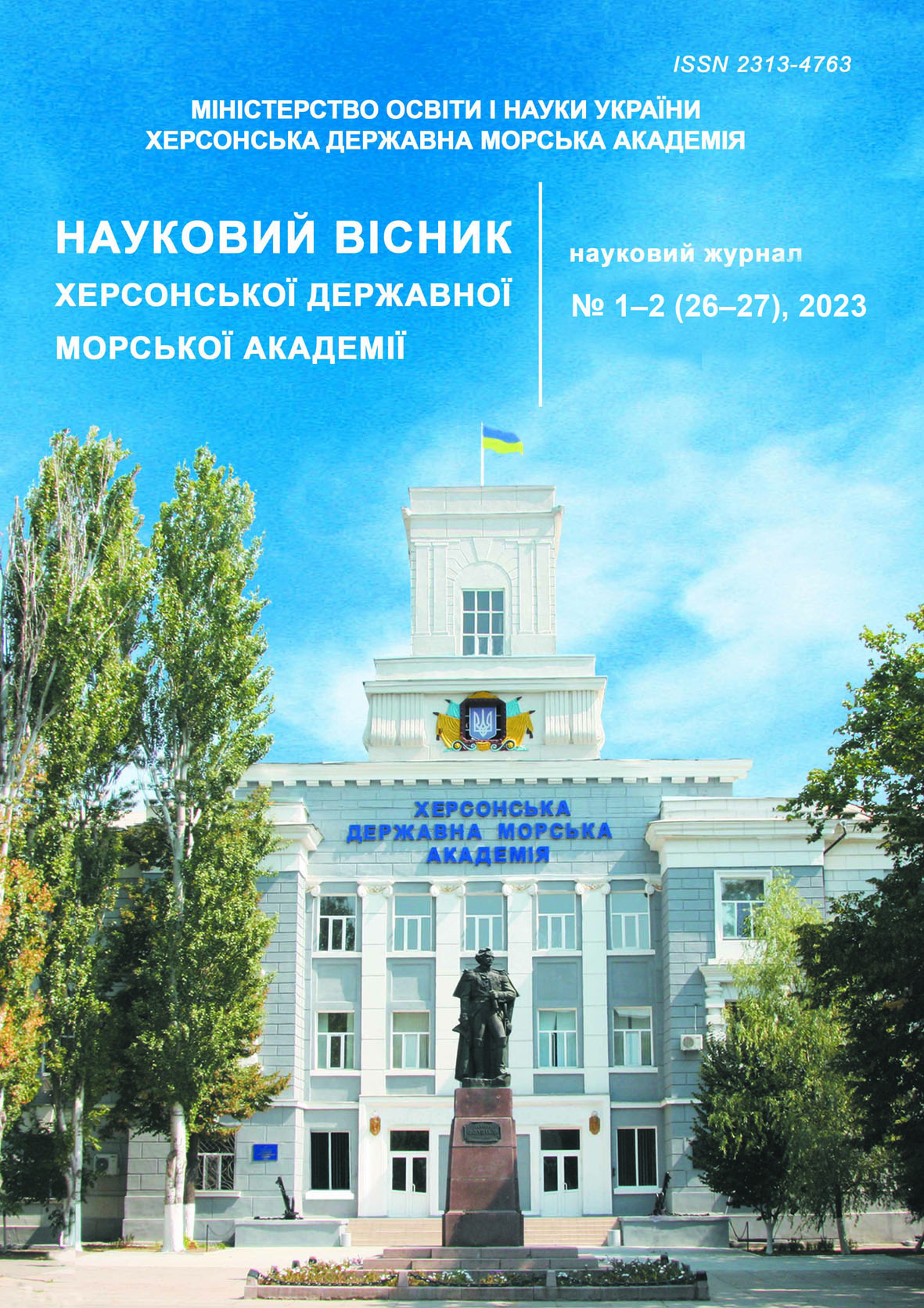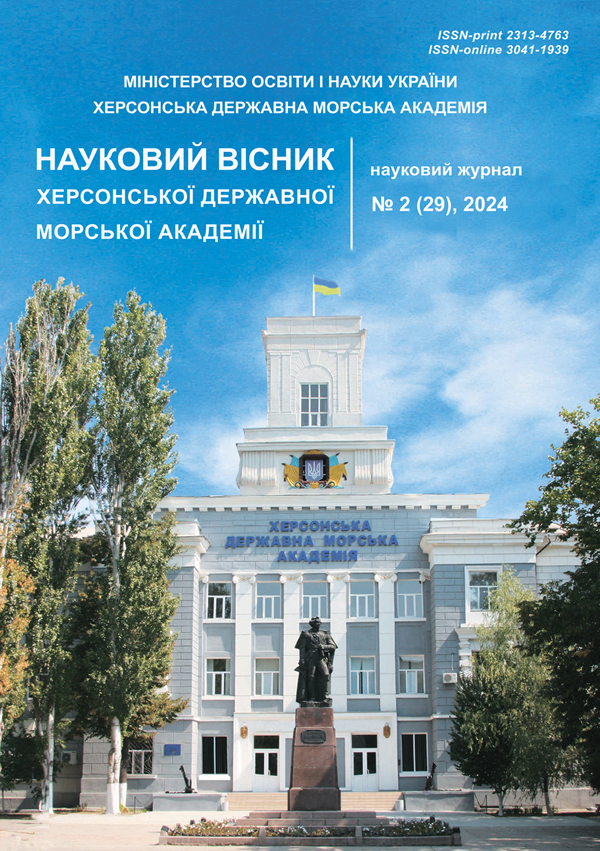INFLUENCE OF HULL AND CARGO CONTOURS ON LATERAL FORCE AND YAW TORQUE IN REAL-TIME VESSEL CONTROL SYSTEMS
https://doi.org/10.33815/2313-4763.2024.2.29.024-034
Abstract
The purpose of the research is to increase the accuracy of control calculations, the efficiency of the control system and the safety of navigation in general, by using a mathematical model in the control system to determine the parameters of external influences in real time. The mathematical model of the vessel is an important element of the mathematical support of the control system, the use of which allows to significantly improve the quality of the control system. Mathematical models are used to predict the movement of the control object, monitor the parameters of the state vector of the control object that are inaccessible to direct measurement, including in noise, determine the failures of command and executive devices, solve optimization problems, etc. In the work, integral functions for determining the resulting lateral force, the resulting yaw torque and the arm of the resulting lateral force, depending on the angle of attack of the flow and the shape of the hull contours, are obtained. The values of integral functions for simple hull contours are calculated. Compared with known approaches to determining the hydrodynamic and aerodynamic interaction of the ship's hull with the environment, the obtained results allow: in comparison with simple models, to estimate external forces and yaw torque much more accurately; in comparison with complex models, to carry out their estimation in real-time control systems. The obtained results are explained by finding and using integral functions for determining the resultant lateral force, resultant yaw torque and resultant lateral force arm, which for simple hull shapes are reduced to analytical solutions. The results are reproducible and can be used in the mathematical support of automated/automatic control systems in real time.
References
2. Kliuiev, O., Sadovoi, O., Serhiienko, S., Sokhina, Yu. (2022). Vykorystannia filtra Kalmana yak sposterihacha stanu u vektornii systemi keruvannia asynkhronnoiu mashynoiu, Elektroenerhetyka, elektrotekhnika ta elektromekhanika. https://doi.org/10.32782/1995-0519.2022.5.
3. Ivaniuk, M. A., Pyskunov, S. O. (2021). Kontroler tysku dlia pnevmatychnoho halma na osnovi filtra Kalmana, Innovatsii molodi v mashynobuduvanni, Vol. 3. https://doi.org/10.20535/ 2708-3926.2021.3.229206.
4. Zinchenko, S. N., Lyashenko, V. G. (2017). Ispol'zovanie nejrosetevoj modeli sudna dlya resheniya zadach upravleniya, Naukovij vіsnik HDMA №2 (17), c. 231–237. http://journals.ksma.ks.ua/nvksma/article/view/587/524.
5. Zinchenko, S. N., Lyashenko, V. G., Shalaeva, A. A. (2017). Ocenka manevrennyh vozmozhnostej sudna s pomoshch'yu nejrosetevoj modeli, sinteziruemoj v processe ego shtatnoj ekspluatacii, Materіali IV MNPK «Bezpeka zhittєdіyal'nostі na transportі a virobnictvі: osvіta, nauka, praktika», Herson, 14–16 veresnya 2017 r., s. 236–240.
6. Zinchenko, S. N., Lyashenko, V. G., Grosheva, O. A. (2018). Sintez optimal'nogo upravleniya sudnom s granichnymi usloviyami, Naukovij vіsnik HDMA №1(18). http://journals.ksma.ks.ua/nvksma/article/view/502/440.
7. Kulikov, D. O., Kupina, O. A., Loriia, M. H., Tselishchev, O. B (2022). Vykorystannia matematychnoi modeli dlia optymizatsii dynamichnykh parametriv protsesiv vyrobnytstva amiaku, Visnyk skhidnoukrainskoho natsionalnoho universytetu im. V. Dalia. https://doi.org/10.33216/ 1998-7927-2022-275-5-49-54.
8. Zinchenko, S. N., Lyashenko, V. G., Shalaeva, A. A. (2017). Raschet i realizaciya manevra raskhozhdeniya s sudami celyami v bortovoj CVM, Materіali IV MNPK «Bezpeka zhittєdіyal'nostі na transportі ta virobnictvі: Osvіta, nauka, praktika», Herson, 14–16 veresnya 2017 r., s. 230–235.
9. Ayub, F. A, Furukawa, Y. (2020). Prediction of Hydrodynamic Forces Acting on Wigley Hull based on SQCM, IOP Conference Series Earth and Environmental Science, 557(1):012015, September 2020. https://doi.org/10.1088/1755-1315/557/1/012015.
10. Kryvyi, O., Miyusov, M. (2019). The Creation of Polynomial Models of Hydrodynamic Forces on the Hull of the Ship with the help of Multi- factor Regression Analysis, 8-th International Maritime Science Conference (IMSC), Budva, Montenegro.
11. Gokulakrishnan, M., Jebin, S., Kumar, A., Vijayakumar, R. (2022). Numerical prediction of hydrodynamic forces and moments of KCS in shallow water, Conference: OCEANS 2022 – Chennai. https://doi.org/10.1109/OCEANSChennai45887.2022.9775441.
12. Bitiukov, M. A., Herasymov, K. D., Kyrylov, P. A., Chystiakov, R. S. (2022). Zastosuvannia chyselnykh metodyk dlia otsinky vplyvu nepriamostinnosti korpusu sudna na velychynu khvylovykh navantazhen, Pratsi Krylovskoho derzhavnoho naukovoho tsentru S-I (1), 98–101 https://doi.org/10.24937/2542-2324-2022-1-S-I-98-101.
13. Davydov, I., Pecheniuk, A. (2023). Doslidzhennia vplyvu formy nosovoi chastyny sudna na yoho opir v umovakh tykhoi vodi ta khvyliuvannia, Visnyk Odeskoho natsionalnoho morskoho universytetu. https://doi.org/10.47049/2226-1893-2023-3-7-20.
14. Chureev, E. A., Romanyuta, D. A., Belousov, V. A., Nikolaev, I. I. (2022). Obosnovanie i vybor osnovnyh harakteristik malogo rybolovnogo sudna s bol'shoj polnotoj korpusa, Izvestiya KGTU. https://doi.org/10.46845/1997-3071-2022-67-71-86.
15. Begovic, E., Panahi, S., Rinauro, B., Rosano, G. (2023). Determination of Hydrodynamic Maneuvering Coefficients of a Planing Hull Using CFD with the Aid of SDT, Progress in Marine Science and Technology, Vol. 7, 65–77. https://doi.org/10.3233/PMST230010.
16. D'omin, S. I., Zhukov Ye. I., Kubachov M. O. ta in. (1991). Keruvannya sudnom: Navchal'nyy posibnyk dlya VNZ. Pid redaktsiyeyu Snopkova V. I., 359 s.






